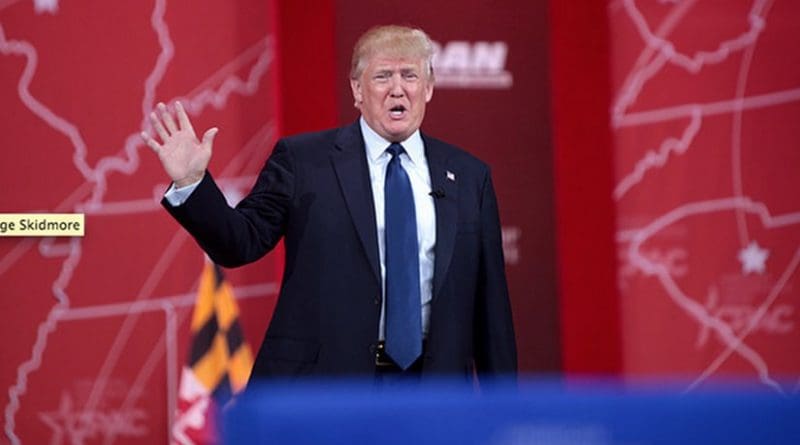Donald Trump And East Asia – Analysis
By IPCS
By Sandip Kumar Mishra*
During the US elections, visualising Donald Trump as the next president was a daunting prospect. China, Japan, and South Korea wished for Hillary Clinton’s victory. Now, however, they have no choice but to accept and recalibrate their options and policies according to this new reality.
It would be wishful thinking to assume that whatever Trump said during his campaign was just to woo voters and that they will not translate into policy. These expectations are also based on the premise that if the Trump administration begins to implement his stated policies, it would cause huge upheaval in East Asian regional politics and the US would therefore not like to do so. It is too premature to predict the shape of Trump’s East Asia policy.
However, as a first step, in the region’s politics, he has created stir by talking to Taiwanese President Tsai Ing-wen over the phone. This is the first time that a president-elect of the US has talked to a top Taiwanese leader and has addressed her as President. This has, expectantly, caused outrage in China. Many analysts opine that it was unnecessary. However, if it is part of a coming tectonic change in the US approach towards East Asia, then it may be seen as a predictable beginning.
By enraging China, Trump probably wants to emphasise that he will have a tougher approach towards China’s manipulation of its currency and its taking advantage of American businesses. Trump also promised that he would take a hard-line on Beijing’s aggressive actions in the East and South China Seas. On 4 December, Trump repeated these charges on Twitter. Trump’s willingness to have a more aggressive posture vis-à-vis China is understandable but if his pronouncements about other countries of the region are taken together, it becomes obvious that there are fundamental contradictions in his position.
Trump has recognised that the US has a capacity and its global presence cannot be continued at the cost of domestic sacrifices. He has said that Japan and South Korea are not contributing enough to the regional security architecture and are taking US security assurances as a free-ride. This would mean that South Korea, which is paying around US$860 million for the presence of 28,000 American soldiers, and Japan, which is paying around US$2 billion for the presence of 50,000 American soldiers, would have to bear the full cost for this military presence. This means that South Korea and Japan, both historical security allies of the US, would have to pay almost double of what they have been paying.
This is indeed a difficult proposition for Japan and South Korea to accept. Trump’s calculations are based on the understanding that Japan and South Korea need US’ security assistance and if they are not ready to pay the full cost, the US should withdraw. However, the US presence is not because of their generosity towards these age-old allies; it is part of its global strategy to have a foothold in East Asia. If Trump is going to be stubborn, Japan and South Korea could decide to force US soldiers out of their soil. In Japanese and South Korean domestic politics, many have articulated the need to secure their interest with US’ help.
Trump appears to be less committed to Japan and South Korea’s security and has said that it is time they think about their own nuclear options. This is again a superficial understanding of the East Asian conundrum. One of the main reasons that Japan and South Korea have not developed nuclear arsenals is because of US pressure, in spite of occasional domestic demands to do so. If the US security commitment to Japan and South Korea gets diluted, they would probably not be hesitant to develop their own nuclear weapons. The presence of China and North Korea in the region, states that they consider hostile, would be a justifiable excuse.
Trump’s approach towards North Korea is not clear, except that he said that he would like to meet North Korean leader Kim Jong-un for direct talks. Direct talks with Kim Jong-un would be a welcome development, as the present policy of the US to isolate, neglect and pressure North Korea has not brought any positive results. However, any such direct negotiations with North Korea must also be communicated to and coordinated with South Korea, Japan and China.
Overall, it seems that Donald Trump wants to counter China without enough good will from Japan or South Korea, and in a situation where the US does not have enough capacity to do so alone. Trump Japan and South Korea to bear the full cost of the US presence in the region but does not recognise that these countries provide a foothold for the US in East Asia. He does not appear to have a problem if Japan and South Korea go nuclear, but may try to denuclearise North Korea, which does not indicate a clear approach towards global nuclear non-proliferation. He wants to have direct talks with North Korea and wants China to play a positive role but also seeks to take a tougher approach towards China.
These are some of the basic contradictions in Trump’s positions on East Asia that he has expressed until now. Although East Asian countries are expecting him to resolve these contradictions, his phone call with the Taiwanese president is not a good sign. However, that is still an act of the president-elect. Once his foreign policy team is constituted and he formally takes over the presidency, the picture will be clearer. Till then, it is a moment of great uncertainty in the minds of regional leaders.
* Sandip Kumar Mishra
Associate Professor, Centre for East Asian Studies, School of International Studies, JNU, & Visiting Fellow, IPCS

